#had not been a consideration in their initial legitimisation
Note
Hi, what exactly did the royal charter excluding the Beaufort family from the throne say?
Hi! So in February 1407, John Beaufort, Earl of Somerset requested that the act legitimatising him and his siblings be confirmed by Letters Patent, which he duly received. At the same time, the royal charter that legitimised the Beauforts was modified by the insertion of the words excepta dignitate regali ("except to royal dignity"). I believe the royal charter is in the Parliament Rolls of Medieval England which I don't have access to but a 19th century historian published a transcription:
Be it remembered, that on Tuesday the fifteenth day of Parliament, the Chancellor, by the King's command, declared how our Holy Father the Pope had, in reverence of the most excellent person of the King, and of his honorable uncle the Duke of Guyenne and of Lancaster, and of his blood, enabled and legitimatized Sir John de Beauford, his brothers and his sister, and that therefore our Lord the King as entire Sovereign of his Realm of England, for the honour of his blood, wills, and hath of his full royal power enabled and of his own proper authority made the said John, his said brothers and sister, muliers, and also pronounced and published the ability and legitimatization according to the form of the King's charter thereof made. The which charter was read in full Parliament and delivered to the said Duke, father of the said John, and his said brothers and sister, the tenor of which charter ensueth. Richard by the grace of God, King of England and France, and Lord of Ireland, to our most dear cousins the noble men, John the Knight, Henry the Clerk, Thomas 'Domicello,' and to our beloved the noble woman Joan Beaufond 'Domicelle,' the most dear relatives of our uncle the noble John Duke of Lancaster, born our lieges, greeting, and the favour of our royal majesty. Whilst internally considering how incessantly and with what honours we are graced by the very useful and sincere affection of our aforesaid uncle, and by the wisdom of his counsel, we think it proper and fit that, for the sake of his merits, and in contemplation of his favors, we should enrich you (who are endowed by nature with great probity and honesty of life and behaviour, and are begotten of royal blood, and by the divine gift are adorned with many virtues,) with the strength of our royal prerogative of favour and grace. Hence it is, that, yielding to the entreaties of our said uncle your father, we do, in the fullness of our royal power and by the assent of Parliament, by the tenor of these presents empower you, who as it is asserted suffer from the want of birthright, (notwithstanding such defect, which, and the qualities thereof, we take to be in these presents sufficiently expressed) to be raised, promoted, elected, assume, and be admitted to all honours, dignities, [except to the royal dignity] pre-eminencies, estates, degrees and offices public and private whatsoever, as well perpetual as temporal, and feodal and noble, by whatsoever names they may be designated, whether they be Duchies, Principalities, Earldoms, Baronies or other fees, and whether they depend or are holden of us mediately or immediately, and to receive, retain, bear, and exercise the same as freely and lawfully as if ye were born in lawful matrimony, and you and every of you do restore and legitimatize : any statutes or customs of our realm of England to the contraiy thereof made or observed (which we consider to be herein fully expressed) in anywise notwithstanding.
(Source: Samuel Bentley, Excerpta Historica, Or Illustrations of English History (1831))
Wars of the Roses historians generally credit this addition to Henry IV, historians of Henry IV to Thomas Arundel, Archbishop of Canterbury who was no Beaufort fan and in a powerful position during this time due to Henry IV's illness.
#i suspect the exclusion was prompted by the fact that the beauforts' position in the succession#had not been a consideration in their initial legitimisation#(not saying it wasn't thought about but that richard ii's solution to the succession problem was basically to put his fingers in his ears#and ignore it so he wouldn't necessarily care because as far as he was concerned he wasn't even naming an heir of his own body)#but henry's accession in 1399 probably ensured that it had to be addressed#another consideration is that henry had a health crisis in 1406#which would bring the succession to the fore in the public mind at a time when the lancastrian dynasty was still pretty fragile#and henry's sons were all still in their teens (late teens - but still teens) which might have made their succession seem more fragile#i'm not saying that henry/arundel viewed the beauforts as a threat to the succession of the prince#but that it may have been motivated by a setting out of the succession to avoid confusion#and to avoid alienating others who were of higher rank and precedence or had better claims (for example - edward duke of york)#beauforts#cardinal henry beaufort#john beaufort earl of somerset#thomas beaufort duke of exeter#joan beaufort countess of westmorland#ask#anon
3 notes
·
View notes
Text
Re-Fridging Mary Winchester? The Ouroboros Narrative Swallows its Origin Story (14x18)

This is the last time we see Mary Winchester alive (14x17 Game Night). Her last words are, “Jack, please, listen to me!” and her last shot is this shaky close-up, straight to camera.
(Image credit Wayward Winchester https://www.youtube.com/watch?v=BIbBibdvsaM )
Doesn’t it look as if she’s directly addressing the audience here, as if to say, “Hey, folks, pay close attention!”?
The “real” Mary is, like the title of the episode (Absence) absent in 14x18.
Rowena says, after doing her locator spell, that Mary, “...is not on this earth.” We see ash that is supposedly hers, as Jack tries desperately to “resurrect” her. We learn Castiel has seen her soul in Heaven, but we do not see her, only the apparent door to her Heaven:
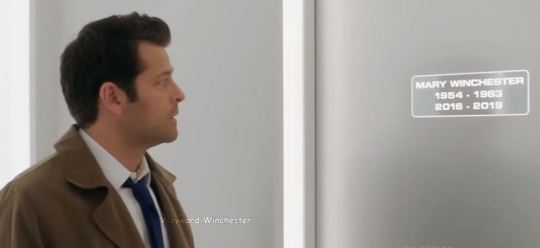
And the “body” Jack raises using Rowena’s necromancy spell? It is not Mary:

(Image credit Wayward Winchester: https://www.youtube.com/watch?v=Ny7tLZC3nto )
Sam is very explicit about that. He says, “I talked to Rowena. She said she thinks that what Jack brought back, he just brought back a shell, a body, y’know, that it was empty, just a... replica, incapable of holding life.”
A replica, like... a doppleganger, a mirror-image?
The shot above, of her sons holding this shell, this replica-double, is laid out at a boundary, between grass and ash, between life and death, almost as if between one world and another (separated, perhaps, by a portal?).
You might have seen my posts already about 14x17 Game Night and 14x18 Absence, wherein I am suspicious (for various reasons) as to whether that is really the last we will see of Mary Winchester on the show. Just as I am suspicious about Jack’s “Hallucifer” really just being a part of his own mind, because likewise, I highly doubt we have seen the last of Lucifer on the show:
http://drsilverfish.tumblr.com/post/183968888069/lucifer-rides-again-games-within-games
http://drsilverfish.tumblr.com/post/184140015899/14x18-absence-the-games-continue
So, my consideration of the re-fridging of Mary Winchester in the S14 SPN narrative is caveated by the fact that I have a sense that this re-fridging may be contingent rather than final.
It is also caveated by the fact that Mary’s second (apparent) fridging was handled by Berens in a way which subverts it, because, as outlined above, Mary herself is absent from the mise-en-scène of her re-fridging. She has noped out of it!
But, if my suspicions concerning another twist to this narrative are incorrect (and I hope they’re not) then, deft or not, Mary is still dead again to further our male protagonists’ narratives.
I think we’re probably all familiar with the term, “fridging”....
The term originates with Gail Simone, a comic book writer who created the website Women in Refrigerators in 1999 (twenty years ago now, wow).
This is the link to the website (still live) and this is an excerpt of what she said:
“This is a list I made when it occurred to me that it's not that healthy to be a female character in comics. I'm curious to find out if this list seems somewhat disproportionate, and if so, what it means, really.
These are superheroines who have been either depowered, raped, or cut up and stuck in the refrigerator. I know I missed a bunch. Some have been revived, even improved -- although the question remains as to why they were thrown in the wood chipper in the first place.”
http://lby3.com/wir/
The trope, “fridging”, has now taken on an established life of its own in pop-culture criticism.
Here is some more discussion of it in an article by Maria Norris “ Comics and Human Rights: A Change is Gonna Come. Women in the Superhero Genre” (2015).
“The trope Simone describes is now widely acknowledged, and the practice it describes has come to commonly known as ‘fridging’. The superhero genre typically depicts interactions and relationships between male and female characters that lack consequence, emotional resonance, permanence and accountability. Often, these fictional relationships stagnate, or end tragically. Too often, women in superhero comics become pawns in schemes meant to develop male characters or give them motivation to act.”
http://eprints.lse.ac.uk/80285/1/Comics%20and%20Human%20Rights_%20A%20Change%20is%20Gonna%20Come.pdf
So, we can define fridging, from these sources as - the often gruesome or shocking death of a female character, for the primary purpose of driving male character motivation or development.
Whilst the trope may have been defined in the 1990s, it is much older in literature. We could argue that Oedipus’ mother, Jocasta, was fridged, for instance, because who she is (Oedipus’ birth mother) and her suicide, are framed as being all about Oedipus and the impact on Oedipus. We could even argue that Shakespeare fridged Ophelia, whose tragic suicide is driven by Hamlet’s cruelty (and his murder of her father) and whose death, in the play, is primarily designed to impact her menfolk - Hamlet (her beloved) and her brother Laertes.
Essentially, what we mean by the “fridging” of a female character is that in stories (usually by men) where men are the protagonists and the heroes (or tragic heroes or anti-heroes) sometimes (by no means always) women are written as primarily existing in relation to those men, so that their own deaths are not about themselves, but are used principally to explore the emotional landscapes of the hero-protagonists to whom they mattered and who live on after they are gone.
Mary Winchester’s original fridging, her gruesome burning on the ceiling, which we the audience see in 1x01 Pilot, provides the origin story for Supernatural.
Mary is fridged because she is dead the moment we meet her.
We don’t have time to get to know who she is, or what her death means as part of her own journey. She is killed gruesomely and that death provides major character motivation and development for her husband John Winchester and for her sons Sam and Dean. She is, originally, defined primarily by her relationships to them; as a dead wife and a dead mother.
Mary Winchester is fridged by fire and her menfolk are thus “birthed” into narrative. Over her silenced and torched corpse, they become words and action. Their narrative journey begins because hers ends.
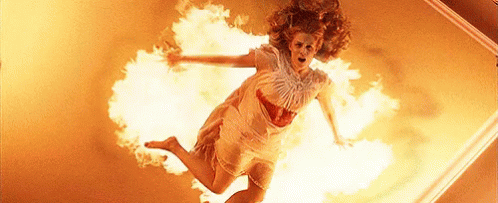
That fridging is, in the very same pilot episode, repeated for Sam’s girlfriend Jess:

Supernatural, it is thus swiftly established (by a double fridging at the outset) is, overtly, a story of heterosexual men (John and Sam being so established by their relationships to Mary and Jess) without familial women. Men who have been initiated into a world of violence and grief, powerfully driven by revenge, because their women-folk have been slaughtered.
(Dean, however, has been queer-coded from the beginning, but that’s another story.)
In the established patriarchal order of the SPN universe (in which stories about men are central and stories about women are peripheral) heightened masculine emotion (which lies at the heart of Supernatural) is thus created and legitimised, by the death of women.
When Bobby becomes the Winchesters gruff substitute father-figure (with a gooey, although masked, heart-of-gold centre) his own back-story repeats the pattern. We learn Bobby had to kill his own wife, Karen, whilst she was possessed by a demon (see 3x10 Dream a Little Dream of Me, 5x15 Dead Men Don’t Wear Plaid, and 7x10 Death’s Door). In Dead Men Don’t Wear Plaid, Karen is raised as a zombie by Death, and Bobby is forced to kill her all over again, thus, once more, reinforcing the death of familial women as the origin point for the centrality of masculine emotion in the narrative. Karen, in the SPN narrative, does not really exist as her own person, only as Bobby’s tragic wife, framed, rather tellingly, as a home-maker and help-meet in this shot from 5x15:
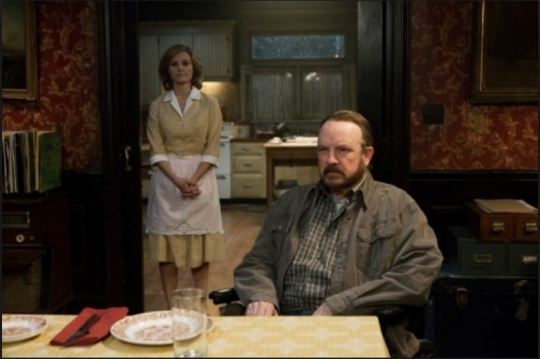
Familial women, associated with the core male characters in Supernatural are thus, initially, strongly framed as occupying the domestic space, the hearth-fire, whilst hunting and the open road belongs to their (bereaved) menfolk.
For Mary Winchester, however, things become a little more complicated than that. Because, thanks to the time-travel abilities of the angels, she is “resurrected” in 4x03 In the Beginning and 5x13 The Song Remains the Same and her sons get to meet a living, younger, version of her. Mary becomes a person, raised as a hunter in her own right, rebellious, brave, independent, determined, a fighter. We see her having something of her own agency, although to a limited extent, in that she remains “trapped” by the angel breeding programme and the fate the angels have laid out for her - to marry John and to bear angel-vessel sons. She cannot therefore, escape her primary framing as a wife and mother, as in this shot from 5x13:
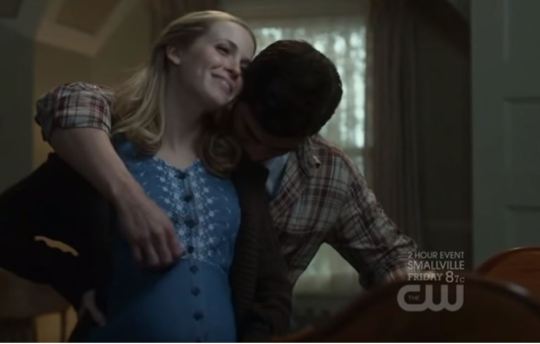
So, when Dabb inaugurated his era as showrunner, and his Ouroboros narrative structure, by taking us back to the start of Superantural and re-working the story by unnfridging Mary Winchester (11x23 Alpha and Omega):
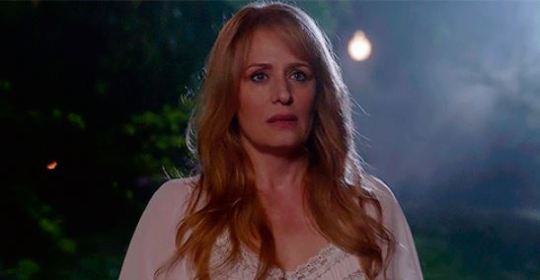
(Image credit: http://timetraveldean.tumblr.com/post/144939142393 )
it was such a brilliant “un-zipping” of the original SPN narrative architecture. The Ur “woman in white” was back from the dead; Supernatural was going meta-narrative on its own ass in a big way. By having Mary brought back to life from Heaven by the feminine God-principle in the universe, Amara, who had previously been unjustly locked away by her brother, God, SPN was critiquing its own patriarchal origin story.
Yay!
Which is why Mary’s re-fridging in 14x18, IF the writers’ room is playing it straight (and, as above, I have my strong doubts about that) would be so disappointing.
Sure, on one level, from Dabb’s Ouroboros narrative perspective, it makes impactful and symmetrical sense.
Jack was always paralleled to Azazel, as well as to Dean and Sam, at his birth - see this meta of mine on 12x23 All Along the Watchtower:
http://drsilverfish.tumblr.com/post/160876601179/all-along-the-watchtower-12x23-and-12x22-and
A yellow-eyed supernatural being in a nursery, a baby, and a mother who dies. The ingredients are the same (1x01 and 12x23) - the recombination is different, as part of the narrative journey.
Mary’s first death inaugurated Dean as substitute-parent to Sam.
Jack’s mother, Kelly Kline’s death, inaugurated the Winchesters as substitute parents to Jack. And oh boy, did the narrative not treat Kelly Kline well. Kelly Kline was stealth-raped by Lucifer and died giving birth to Jack (her body mystically ripped apart by the birth). Kelly was fridged for Jack’s nascent emotional journey, because, once again, the show’s core depends on the absence of familial women.

Kelly Kline dies giving birth to Jack (12x23)
Jack’s birth and Sam and Dean’s parental responsibility for him also coincided with Castiel’s death, thus (in subtext) the narrative also mirrored Dean’s grief at losing Cas to his father John Winchester’s grief at losing Mary.
In a patriarchal culture where male feeling is repressed, which is definitely the in-show world of Supernatural (mirroring aspects of IRL US culture) the stakes, apparently, “have to” be bloody, they “have to” be high, in order for the narrative to “permit” the levels of traumatic emotion which Dean and Sam (and now Jack) continually cycle through, whilst maintaining their ostensibly “tough” hunter hero status.
The bedrock of that “permission”, i.e. permission to be a show about male sentiment? With Kelly Kline’s death, it continued to be predicated on the violent death of familial women - at the very moment the Winchesters themselves became fathers.
Dabb used the same (tired) trope in 9x20 Bloodlines (Ennis lost his girfriend to a werewolf attack, and was thus deeply emotionally wounded and bent on revenge).
Female familial death is the narrative “excuse” for the homo-social world of SPN, and it also works to contain the homoerotic subtext of SPN. Women are ostensibly, only absent from these men’s lives because they keep traumatically losing them, not because they, in fact, prefer the company of other men.
Two grown brothers and a male-embodied angel who live together, have adopted a son together, and who spend all their time in states of incredible emotional angst?
Hollywood culture (and the mainstream audience it imagines it is speaking to) still (for the most part - although let’s acknowledge Tapert’s Spartacus for Starz, 2010-2013) cannot compute how to experience that kind of set-up as both “queer” AND “manly” (which is why Troy [2004] eviscerates the homo-romantic from Achilles/ Patroclus) so the violent death of familial women in Supernatural is used as an excuse for their absence
Mary’s ostensible death in 14x18 seems, once again, to re-affirm this patriarchal order, even though, in her time back on earth, from 11x23 to now, Mary has been written and portrayed as a flawed, real person; her apple-pie baking, perfect Mom, childhood mirage (Dean’s dream of her idealised memory) thoroughly deconstructed. And I have lived for that.
To have her re-fridged, for her sons’ man-pain (i.e. for the narrative “permission” to cycle through grief and angst and growth again) after all that, just sits wrong with me.
And, despite the beauty of Beren’s structure, despite his respectful treatment of her, make no mistake, Mary is (if we read this as played straight) re-fridged, because her death, is not about her or her own journey, rather, narratively, it now deliberately leaves her sons in the place of their father.
A yellow-eyed “demon” (their adopted Nephilim son Jack, whom they fear has lost his soul) has killed Mary Winchester, again. Will the Winchesters follow in the footsteps of John Winchester’s revenge quest, or will they find another way?
I really hope Mary comes back from the AU world she’s been un-wittingly blasted to by Jack to kick some sense into her sons’ asses and, oh yeah, punch Lucifer in the face all over again:

Mary punching Lucifer in 13x22 Exodus.
#Supernatural#14x18#Absence#spn meta#Meta#Re-fridging Mary Winchester#Ouroboros narrative#Dabb era spiral narrative#Jack the Nephilim#Azazel#Narrative mirrors#Winchester Family Dynamics#14x17#Game Night#1x01#Pilot#3x10#Dream a Little Dream of Me#5x15#Dean Men Don't Wear Plaid#7x10#Death's Door#4x03#In the Beginning#5x13#The Song Remains the Same#11x23#Alpha and Omega#12x23#All Along the Watchtower
69 notes
·
View notes
Photo

- Isobel Robinson
This is more a written piece rather than spoken word! I wrote it after a break up and it was super therapeutic !!! I also submitted it as an assignment for a class I was taking at the time about Renaissance poetry and literary imitation... Here is the short commentary attached:
Reflection on Imitation
To begin, I intend to make some opening remarks about my approach to writing my ‘sonnet’, followed by a line-by-line commentary which should serve to elucidate individual linguistic, rhetorical and grammatical decisions. The primary emotional context of the poem’s genesis was the breakdown of my relationship with my now ex-boyfriend, thus the tone of my ‘pseudo-sonnet’ and the poetic voice I have chosen to invoke are petty, ironic and somewhat histrionic in places, but not without a degree of sincerity.
At the time of writing, I had been reading on Petrarch and Petrarchism interspersed with Nietzsche, which was required reading for another module I am taking. I subsequently decided to ironise, through a poetic dialogue, both humanist and anti-humanist tenets. During my reading, the humanist reification of classical rhetoric (such as Ciceronianism) as the pinnacle of literary writing frustrated my postmodern, fourth wave feminist, Marxist1 and millennial sympathies. Fascinated with critical debate on literary aesthetics, I considered the various sources of inspiration which inform my own poetic style. There is something, I find, in the poetics of obsession. From Petrarch’s 366 unanswered poems in the Rime Sparse (taking the millennial notion of ‘double texting’ to the next level), to Carol Ann Duffy’s narrative love-poem(s) in ‘Rapture’, I observed that there is something about the dialectic between the object of desire and the formulation of the self which is literarily irresistible. I have taken inspiration from these texts and paired this with the ironisation of the humanist dilemma2 and postmodern solipsist and totalising propensities. The formulation of a specifically female, millennial, postpostmodern écriture that is at once confessional, candid and interrogative was another stylistic consideration.
The title of the poem focalises the poetic narrative through the medium and discourse of
1 See ‘Aesthetics and Politics’ for Marxian discourse on autonomous art and notion of genius. 2 Simultaneous anxiety of influence and unflinching reification of genius.
obsession. I took the Biblical figure of the archangel Gabriel as a poetic substitution for my beloved and the initial image of Gabriel as the deliverer of the news of the Virgin Mary’s ‘fullness’ to serve as a metaphor for the sense of completion I associated with my ex-boyfriend; using the character as an extended metaphor for the fallacy of fulfilment of the self by (an)other. My decision to add the parentheses ‘By Monna Innominata’ was inspired by my reading of Christina Rossetti’s sonnet series, which both imitates and surpasses the work of seminal male sonneteers—primarily Petrarch and Dante (Moore 485). It plays on the notion of the female as object of desire and asserts a specifically female voice.
In my writing, I tend to play with indentation, enjambment, punctuation and stanzas fairly unconventionally. The opening stanza of the poem features two indented lines, which I have suspended in the middle of the page to reflect their meaning. The phrase ‘creation fable’ is a reference to the beginning of Nietzsche’s ‘On Truth and Lies in a Nonmoral Sense’, where he uses a demonstrative literary rhetoric to establish his theory of ‘truth’ as a human act of associative metaphorisation. This is an important theme throughout the sonnet, as I explore the notion of subjectivity and validity of experience of the self in unrequited love. The opening line is also in iambic pentameter, but I subsequently break the metre in the vein of Carol Ann Duffy, and the way she takes then breaks traditional sonnet forms to emphasise the unconventionality of her love poems. With the phrase ‘amputeed again’ I begin the motif of the disembodiment of the beloved. This is in part direct reference to Petrarch’s ‘scattering of Laura's physical features as a kind of defence tactic, one that works against the "threat of [his own] imminent dismemberment" implicit in his reworking of the Actaeon-Diana myth towards the end of canzone 23’ (Vickers in Leubner: 1081), and also Carol Ann Duffy’s ‘Absence’ (Duffy: 10) which examines the relationship between desire and objectification of the beloved. The line ‘left hand man’ is reference to Jewish portrayals of Gabriel as standing at the left hand of God (Alder 1906: 540–543). It also creates an oppositional structure with ‘right’ in the following line, in typical Petrarchan parallelism. Subsequently, the phrase ‘mythicised into the right side of the bed’, invokes a sense of the contemporary poet as capable of mythologising.
The last few lines of this stanza further the fragmentation of the beloved, whilst involving a a sense of the preservation of loss and the continuation of desire following the untenability of a relationship. The semantic field of food is employed to portray the object of desire as consumable and materialised through the creative act—this is something also explored with the reference to ‘engobe’; the idea of forming the beloved (in retaliation to thinking that my ex-boyfriend completed me). I use curly brackets in this phrase to reference my beloved’s mathematical and musical background; in music, braces can connect lines that are played simultaneously, whilst mathematical sets are used to group together distinct objects which are also considered as a whole. Therefore, my use of punctuation here communicates the simultaneity of the relationship being at once over and enduring through my own experience of the aftermath, as well as the notion of separation of the self and the beloved in a couple. This is echoed with the floating semicolon in the next line. The final line of the first stanza uses a slant rhyme with ‘peaches’ to mirror the alternate end rhyme structure of the Shakespearean sonnet (but also in the sestet of Petrarchan sonnets). It is a direct, retrospective and ironic reference to lines 13 and 14 of Rossetti’s ‘Sonnet 1’, playing on the idea of the mediation of experience of the self through the validation of the beloved. I wanted to incorporate here the sense of a female subjectivity, which Rossetti enacts using ‘rhetoric and figuration like those of Petrarch, including the rhetoric of self-analysis that fragments his speaker, but emphasising aural over visual sensuousness and thus avoiding visual imagery and metonymic praise, techniques that objectify the female or feminised beloved’ (Moore: 487).
The second stanza of my poem features a volta face. The tone of the stanza becomes more polemical and petty, which is mirrored by the playful euphony and prosody of its sound and the quickening of the pace administered through sibilance, alliteration and litany. The caesura following the phrase ‘like a club-foot’ is a metapoetic element following Nietzsche, which literally appendages the phrase from the rest of the verse. The rest of the stanza works through wordplay and reference to Ancient Rome. Whilst writing these lines I considered Petrarch’s RVF 85 and the line
‘love with what power today you vanquish me’ (Durling: 188); the idea of love as violent or imperial. I also imitated to some extent RVF 128 and the artistic implications of politicising (in my case asserting female agency and strength) alongside eroticism and desire (Durling: 256). Petrarch here attempts to recompose the fragments of his beloved motherland, but I have chosen to leave my object of affection dismembered and scattered over the page. For clarification, the phrase ‘reached in the Guf’ is another reference to Jewish scripture about Gabriel. My ex-boyfriend has Jewish heritage, and I liked the image of Gabriel picking souls out of a chamber to bring them into existence. This is again playing on the notion that I felt validated and legitimised by the relationship, but the flippant tone ironises this retrospectively.
I chose to stand the line ‘let this be your columbarium’ alone to act as a link between the images invoked in the second and fourth stanza. It refers to Nietzsche’s essay and his criticism of scientific and mathematic rigidity (Nietzsche: 112). The line also serves to juxtapose the image of the death of a relationship as an extinguished flame (in the spirit of Petrarch’s leitmotif of fire and ice) with a typical image of peace associated with weddings (the dove). Obviously this is also a nod to Ancient Rome, whence came the columbarium3.
The final stanza continues my use of colloquialised text-speak (inspired by Carol Ann Duffy’s use of text references to modernise and parody her relationships) in direct address to the subject. The address is at once interrogative and a direct allusion to lines from Nietzsche’s ‘On Truth and Lies in a Nonmoral Sense’ in which he asserts the sublimity of the ‘perceptual metaphor’ over empiricism (Nietzsche: 112). The closing lines of the poem use the anaphora of the dental plosive ‘truth’ to cacophonically reassert the tongue-in-cheek forcefulness of the poetic voice’s tone. I chose to finish the sonnet with a rhyming couplet to deviate from the typical Petrarchan sonnet, and evoke my national vernacular tradition in that many forms of English sonnets culminate in a rhyming couplet.
Bibliography
Adler, Cyrus, and Isidore Singer, The Jewish Encyclopaedia (New York: Funk & Wagnalls Company, 1906), pp. 540–543.
Duffy, Carol Ann, “Rapture”, (London: PICADOR, 2017), p. 10
Leubner, Jason, "Temporal Distance, Antiquity, And The Beloved In Petrarch's Rime Sparse And Du Bellay's Les Antiquitez De Rome", MLN, 122 (2007), 1079-1104 <https://doi.org/10.1353/mln.2008.0028>
Moore, Mary. “Laura's Laurels: Christina Rossetti's ‘Monna Innominata’ 1 and 8 and Petrarch's ‘Rime Sparse’ 85 and 1.” Victorian Poetry, vol. 49, no. 4, 2011, pp. 485–508. JSTOR, www.jstor.org/stable/ 23079669.
Nietzsche, Friedrich, "On Truth And Lies In A Nonmoral Sense", in From Modernism To Postmodernism (Oxford: Blackwell, 2003), pp. 109-116
Petrarca, Francesco, and Robert M Durling, Petrarch's Lyric Poems (Cambridge: Harvard University Press, 2001), pp. 188, 256
Rossetti, Christina Georgina, and Simon Humphries, Poems And Prose (Oxford: Oxford University Press, 2008), p. 227
3 Etymologically derives from Latin ‘columba’, referred to compartmentalised dovecote.
0 notes